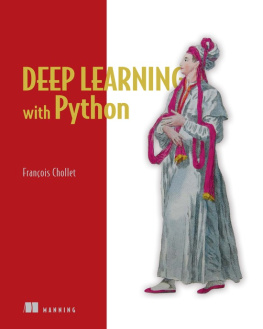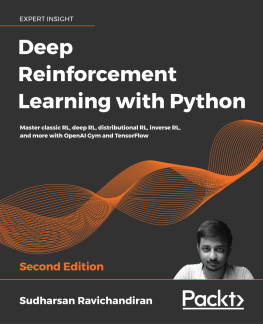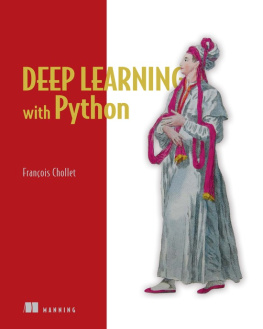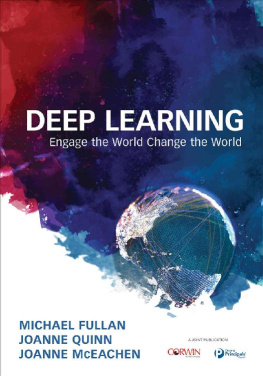Francois Chollet - Deep Learning with R, Second Edition
Here you can read online Francois Chollet - Deep Learning with R, Second Edition full text of the book (entire story) in english for free. Download pdf and epub, get meaning, cover and reviews about this ebook. year: 2022, publisher: Manning Publications, genre: Children. Description of the work, (preface) as well as reviews are available. Best literature library LitArk.com created for fans of good reading and offers a wide selection of genres:
Romance novel
Science fiction
Adventure
Detective
Science
History
Home and family
Prose
Art
Politics
Computer
Non-fiction
Religion
Business
Children
Humor
Choose a favorite category and find really read worthwhile books. Enjoy immersion in the world of imagination, feel the emotions of the characters or learn something new for yourself, make an fascinating discovery.

- Book:Deep Learning with R, Second Edition
- Author:
- Publisher:Manning Publications
- Genre:
- Year:2022
- Rating:3 / 5
- Favourites:Add to favourites
- Your mark:
- 60
- 1
- 2
- 3
- 4
- 5
Deep Learning with R, Second Edition: summary, description and annotation
We offer to read an annotation, description, summary or preface (depends on what the author of the book "Deep Learning with R, Second Edition" wrote himself). If you haven't found the necessary information about the book — write in the comments, we will try to find it.
Deep Learning with R, Second Edition — read online for free the complete book (whole text) full work
Below is the text of the book, divided by pages. System saving the place of the last page read, allows you to conveniently read the book "Deep Learning with R, Second Edition" online for free, without having to search again every time where you left off. Put a bookmark, and you can go to the page where you finished reading at any time.
Font size:
Interval:
Bookmark:
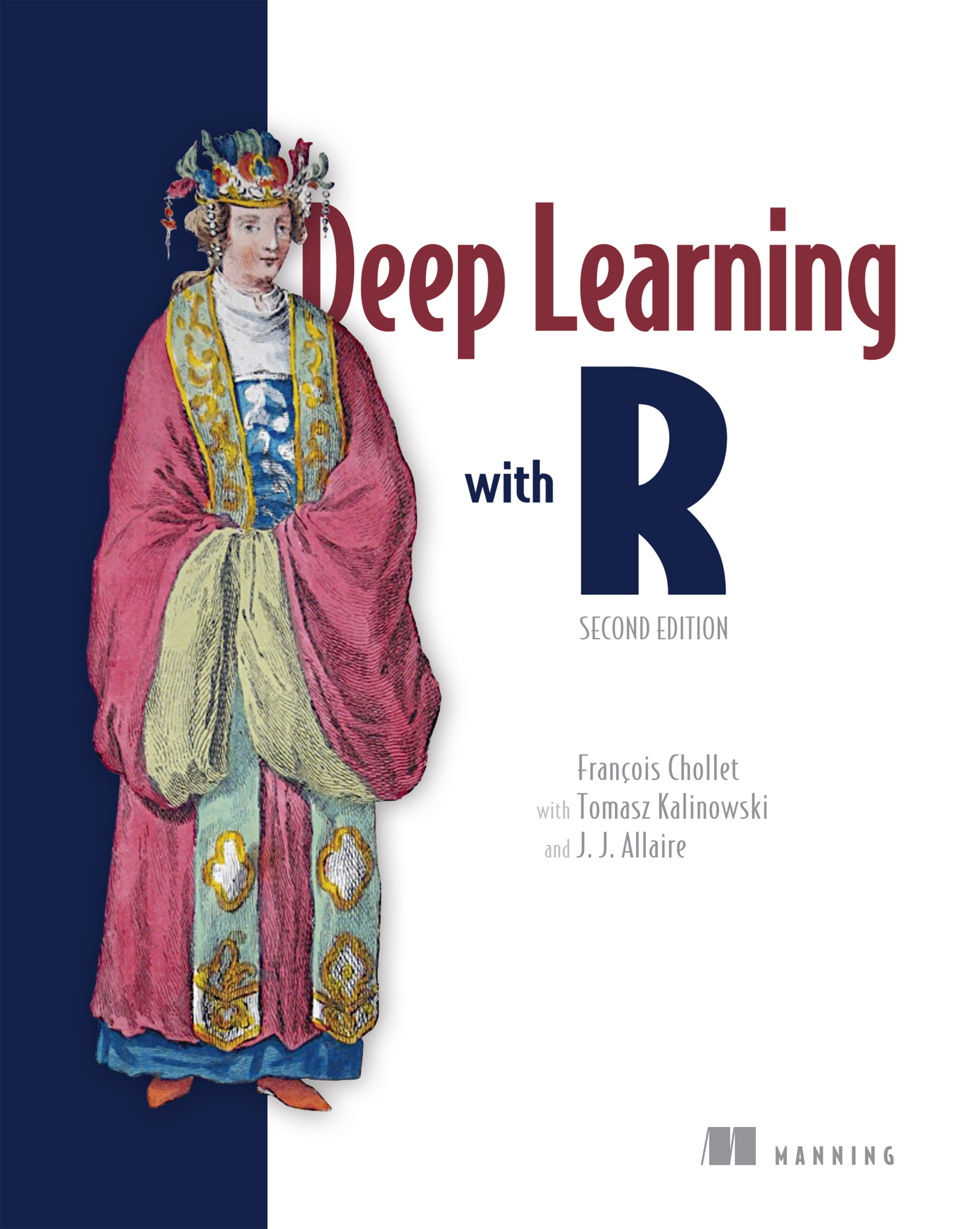
Deep Learning with R, Second Edition
Francois Chollet with Tomasz Kalinowski and J. J. Allaire

The clearest explanation of deep learning I have come across it was a joy to read.
Richard Tobias, Cephasonics
Bridges the gap between the hype and a functioning deep-learning system.
Peter Rabinovitch, Akamai
All major topics and concepts of deep learning are covered and well-explained, using code examples and diagrams instead of mathematical formulas.
Srdjan Santic, Springboard.com
For online information and ordering of this and other Manning books, please visit www.manning.com. The publisher offers discounts on this book when ordered in quantity. For more information, please contact
Special Sales Department
Manning Publications Co.
20 Baldwin Road
PO Box 761
Shelter Island, NY 11964
Email:
2022 by Manning Publications Co. All rights reserved.
No part of this publication may be reproduced, stored in a retrieval system, or transmitted, in any form or by means electronic, mechanical, photocopying, or otherwise, without prior written permission of the publisher.
Many of the designations used by manufacturers and sellers to distinguish their products are claimed as trademarks. Where those designations appear in the book, and Manning Publications was aware of a trademark claim, the designations have been printed in initial caps or all caps.
Recognizing the importance of preserving what has been written, it is Mannings policy to have the books we publish printed on acid-free paper, and we exert our best efforts to that end. Recognizing also our responsibility to conserve the resources of our planet, Manning books are printed on paper that is at least 15 percent recycled and processed without the use of elemental chlorine.
The author and publisher have made every effort to ensure that the information in this book was correct at press time. The author and publisher do not assume and hereby disclaim any liability to any party for any loss, damage, or disruption caused by errors or omissions, whether such errors or omissions result from negligence, accident, or any other cause, or from any usage of the information herein.

Manning Publications Co.
20 Baldwin Road
PO Box 761
Shelter Island, NY 11964
Development editor: Jennifer Stout
Review editor: Aleksandar Dragosavljevi
Production editor: Andy Marinkovich
Copy editor: Pamela Hunt
Proofreader: Keri Hales
Technical proofreader: Ninoslav Cerkez
Typesetter: Gordan Salinovic
Cover designer: Marija Tudor
ISBN 9781633439849
ISBN 9781638350781 (ebook)
If youve picked up this book, youre probably aware of the extraordinary progress that deep learning has represented for the field of artificial intelligence in the recent past. We went from near-unusable computer vision and natural language processing to highly performant systems deployed at scale in products you use every day. The consequences of this sudden progress extend to almost every industry. Were already applying deep learning to an amazing range of important problems across domains as different as medical imaging, agriculture, autonomous driving, education, disaster prevention, and manufacturing.
Yet, I believe deep learning is still in its early days. It has realized only a small fraction of its potential so far. Over time, it will make its way to every problem where it can helpa transformation that will take place over multiple decades.
To begin deploying deep learning technology to every problem that it could solve, we need to make it accessible to as many people as possible, including non-experts people who arent researchers or graduate students. For deep learning to reach its full potential, we need to radically democratize it. And today, I believe that were at the cusp of a historical transition, where deep learning is moving out of academic labs and the R&D departments of large tech companies to become a ubiquitous part of the toolbox of every developer out therenot unlike the trajectory of web development in the late 1990s. Almost anyone can now build a website or web app for their business or community of a kind that would have required a small team of specialist engineers in 1998. In the not-so-distant future, anyone with an idea and basic coding skills will be able to build smart applications that learn from data.
When I released the first version of the Keras deep learning framework in March 2015, the democratization of AI wasnt what I had in mind. I had been doing research in machine learning for several years and had built Keras to help me with my own experiments. But since 2015, hundreds of thousands of newcomers have entered the field of deep learning; many of them picked up Keras as their tool of choice. As I watched scores of smart people use Keras in unexpected, powerful ways, I came to care deeply about the accessibility and democratization of AI. I realized that the further we spread these technologies, the more useful and valuable they become. Accessibility quickly became an explicit goal in the development of Keras, and over a few short years, the Keras developer community has made fantastic achievements on this front. Weve put deep learning into the hands of hundreds of thousands of people, who in turn are using it to solve problems that were until recently thought to be unsolvable.
The book youre holding is another step on the way to making deep learning available to as many people as possible. Keras had always needed a companion course to simultaneously cover the fundamentals of deep learning, deep learning best practices, and Keras usage patterns. In 2016 and 2017, I did my best to produce such a course, which became the first edition of this book, released in December 2017. It quickly became a machine learning best seller that sold over 50,000 copies and was translated into 12 languages.
However, the field of deep learning advances fast. Since the release of the first edition, many important developments have taken placethe release of TensorFlow 2, the growing popularity of the Transformer architecture, and more. And so, in late 2019, I set out to update my book. I originally thought, quite naively, that it would feature about 50% new content and would end up being roughly the same length as the first edition. In practice, after two years of work, it turned out to be over a third longer, with about 75% novel content. More than a refresh, it is a whole new book.
I wrote it with a focus on making the concepts behind deep learning, and their implementation, as approachable as possible. Doing so didnt require me to dumb down anythingI strongly believe that there are no difficult ideas in deep learning. I hope youll find this book valuable and that it will enable you to begin building intelligent applications and solve the problems that matter to you.
First, Id like to thank the Keras community for making this book possible. Over the past six years, Keras has grown to have hundreds of open source contributors and more than one million users. Your contributions and feedback have turned Keras into what it is today.
Font size:
Interval:
Bookmark:
Similar books «Deep Learning with R, Second Edition»
Look at similar books to Deep Learning with R, Second Edition. We have selected literature similar in name and meaning in the hope of providing readers with more options to find new, interesting, not yet read works.
Discussion, reviews of the book Deep Learning with R, Second Edition and just readers' own opinions. Leave your comments, write what you think about the work, its meaning or the main characters. Specify what exactly you liked and what you didn't like, and why you think so.

